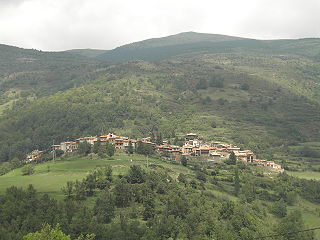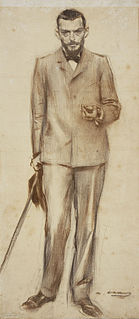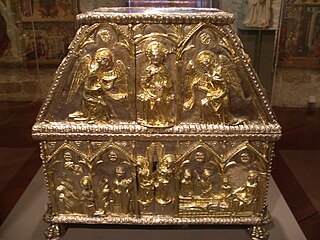
Josep Puig i Cadafalch was a Catalan Spanish Modernista architect who designed many significant buildings in Barcelona, and a politician who had a significant role in the development of Catalan institutions. He was the architect of the Casa Martí, which became a place of ideas, projects and social gatherings for such well-known Catalans as Santiago Rusiñol and Ramon Casas.

The Palau de la Generalitat de Catalunya is a historic palace in Barcelona, Catalonia, Spain. It houses the offices of the Presidency of the Generalitat de Catalunya. It is one of the few buildings of medieval origin in Europe that still functions as a seat of government and houses the institution that originally built it.

The County of Barcelona was originally a frontier region under the rule of the Carolingian dynasty. In the 10th century, the Counts of Barcelona became progressively independent, hereditary rulers in constant warfare with the Islamic Caliphate of Córdoba and its successor states. The counts, through marriage, alliances and treaties, acquired the other Catalan counties and extended their influence along Occitania. In 1164, the County of Barcelona entered a personal union with the Kingdom of Aragon. Thenceforward, the history of the county is subsumed within that of the Crown of Aragon, but the city of Barcelona remained preeminent within it. Within the Crown, the County of Barcelona and the other Catalan counties developed a common polity known as the Principality of Catalonia.

El Papiol is a municipality in the comarca of the Baix Llobregat in Catalonia, Spain. It is situated on the left bank of the Llobregat river, on the A-7 autopista from Valencia to La Jonquera and the C-1413 road from Sabadell to Molins de Rei. At West it borders on Castellbisbal and Pallejà, at North on Valldoreix and at East on Molins de Rei. It is served by the RENFE railway line R4 from Barcelona to Martorell, Vilafranca del Penedès and Sant Vicenç de Calders, which is connected to the village center by a minibus service. It is also served by a bus service (L67) and a night bus service (N51) from Barcelona to Esparreguera.

Isona i Conca Dellà is a municipality in the comarca of the Pallars Jussà in Catalonia, Spain. It is situated in the valley of the Conques river in the south-east of the comarca. It was formed in 1970 by the fusion of the following municipalities: Isona, Basturs, Benavent de la Conca, Biscarri, Conques, Covet, Gramenet, Llordà, Masos de Sant Martí, Montodó, Orcau i Figuerola d'Orcau, Sant Romà d'Abella and Siall. The town hall is in Isona. The municipality is served by the C-1412 road between Artesa de Segre and Tremp, and is linked to Coll de Nargó by the L-511. It includes a small exclave to the south.

Bernard II was the Count of Besalú and Ripoll in Catalonia, the brother, co-ruler, and successor of William II, who was assassinated in 1066. The second son of William I of Besalú and his wife, Adelaide, Bernard married his first cousin Ermengarda, daughter of Ponç I of Empúries and Adelaide, sister of William I.

The national symbols of Catalonia are flags, icons or cultural expressions that are emblematic, representative or otherwise characteristic of Catalonia or Catalan culture.

Pardines is a municipality in the comarca of Ripollès, province of Girona, Catalonia, Spain.

Plaça de Mossèn Jacint Verdaguer is a square in the Eixample district of Barcelona, Catalonia, Spain. It lies in the intersection between Avinguda Diagonal, the city's main avenue, and Passeig de Sant Joan, in Dreta de l'Eixample, not far from the Sagrada Família.

Josep Llimona i Bruguera was a Catalan sculptor. His first works were academic, but after a stay in Paris, influenced by Auguste Rodin, his style drew closer to modernisme. He was very prolific, and exhibited in Catalonia, Madrid, Paris, Brussels and Buenos Aires. Some of his monumental work is familiar to Barcelona residents and visitors alke.

Sant Pere de Torelló is a municipality in the comarca of Osona in Catalonia, Spain.

Rodalies de Catalunya is the main commuter and regional rail system in the Spanish autonomous community of Catalonia. It is administered by the Government of Catalonia and operated by the national rail operator Renfe Operadora. The system consists of 17 service lines chiefly centered in the Barcelona area, serving a total of 203 stations throughout Catalonia, with an average number of 1,000 trains running on it every day. In 2016, it had an annual ridership of 117 million.

Altafulla is a municipality in the comarca of the Tarragonès in Catalonia, Spain. The town of Altafulla has a beautifully intact old quarter crowned by the Castle of Altafulla, an additional medieval castle on a small promontory overlooking the sea and an old fishing quarter dating back to the 18th century along the beach, called "Baixamar" or "Les Botigues del Mar". Beyond the Castle of Tamarit is one of the last remaining forests stretching along the sea in Catalonia, part of which is a small nature preserve. It is also home to the remains of the Roman Villa of Els Munts, which is part of a larger UNESCO World Heritage Site. The Gaià River "empties" into the sea here, its last stretch being a small nature preserve and haven for songbirds, though due to damming upriver, it carries very little water at this last section, forming a tiny salt marsh separated from the sea by a bar of sand. This wildlife preserve is run by L'Hort de la Sínia, an ecological agriculture, learning and activities center.

Catalunya en Miniatura is miniature park inaugurated in 1983 in Torrelles de Llobregat, 17 km from Barcelona. The park is 60,000 square meters, 35,000 of them devoted to the scale models, it is one of the largest miniature parks in the world, and the largest of the 14 miniature building exhibitions present in Europe. It displays 147 models of palaces, churches, bridges and other buildings from Catalonia and Mallorca and it includes all the major works by the renowned architect Antoni Gaudí.
Josep Masgoret i Marcó was one of the main warlords of the Carlists of Catalonia in the Second Carlist War.
Llarg de Copons was one of the main warlords of the Carlists of Catalonia in the Second Carlist War (1846–49).
Pere Puig Subinyà was a Catalan politician and businessman. He was a member of Unió de Rabassaires and Republican Left of Catalonia

The casket of Sant Cugat is a reliquary of gold from the beginning of the fourteenth century. It is made with embossed silver plates engraved and partly superimposed on a golden casket of wood, depicting scenes from the life and death of the martyr Saint Cugat. Its makers were Joan de Gènova and Arnau Campredon. During the seventeenth century, it was dismantled and built in a smaller size in which the plates were reused from the previous silver.
Ramon Amigó Anglès (1925–2011) (Spanish) was a writer, a teacher of Catalan and an onomast.


















